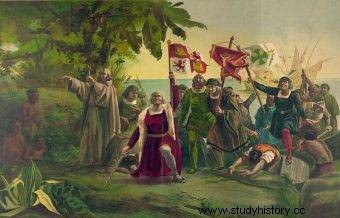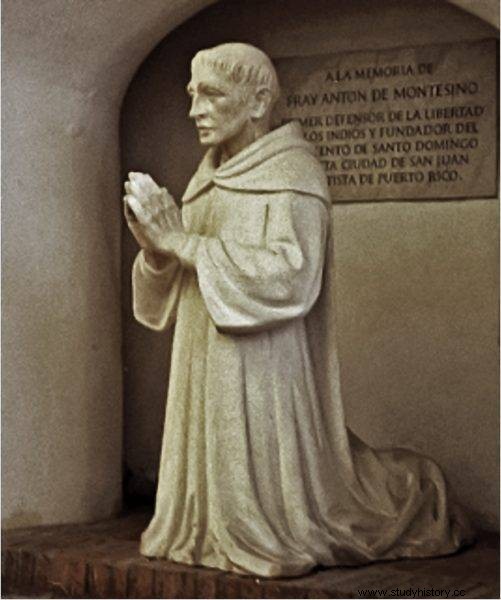The figure of Christopher Columbus is associated today mainly with the discovery of America. But just as important is the fact that the arrival of the sailor off the shores of the New World started a shockingly rapid process of ruthlessly decimating the local population.
The end of the fifteenth century was the beginning of the era of the conquest of the New World and the prosperity that flowed from it - only for Christians, of course. Slavery was nothing unusual at the time. " People used to enslave their enemies, people who were considered different enough to be sentenced to life surrender ”Writes Jill Lepore.
[…] captured in African wars were bought and sold at large markets by merchants, local dignitaries and rulers, and from the 1550s by Portuguese sailors. […] In sugar and gold mines, the Spaniards gave their local slaves to work, and many more died of disease. Soon the Spaniards turned to another source of forced laborers - the Africans traded by the Portuguese.

The arrival of Columbus on the coast of the New World began a shockingly rapid process of ruthlessly decimating the local population.
Christopher Columbus was a sailor brought up in the belief that the division between masters and slaves was the natural order of things. From 1482, he sailed on Portuguese slave ships, but apparently felt the call of the discoverer so strong that in 1484 he presented the king of Portugal with a design for a sea route to Asia.
The monarch rejected his idea, so the ambitious sailor turned to the king and queen of Spain - they agreed, and at the same time commissioned Columbus to keep a diary. Notes by an accidental discoverer of a new land are perhaps not entirely reliable, but the main source of knowledge about his landing in Haiti.
Divide, rule, rape ...
Historians estimate that when Columbus appeared on unknown land, the indigenous population was about three million people. Fifty years later, only five hundred remained. The rest died of diseases, exhausted by slave labor or simply murdered. "With fifty people, you can keep them all in check and you can tell them to do whatever you want," reported the fearless explorer Ferdinand and Isabella. Anyway, he did so, having behind him the European ideology of promoting faith and civilization ... But is it really?
Colonies founded by Columbus were not a friendly place to live. The aborigines were accused of various offenses at every opportunity, and then mutilated or beheaded as punishment. The same was true of the colonists who were treated equally harshly by the famous sailor.

Columbus returned to Spain as a winner, although the Native Americans certainly did not share his enthusiasm
His subordinates like the officer Margarita were no better. Before returning to Europe, Columbus entrusted him with sovereignty over the colony and commissioned the Christianization of the local population; instead, the Indians were murdered, raped, and enslaved. None of the people in Haiti have been baptized.
Columbus found out about Margarita's actions and… did not pull the consequences. Instead, he sent about 500 slaves to Spain. He also used the locals for forced labor in gold mines, justifying their conduct with allegations of cannibalism or crimes.
Meanwhile, Pope Alexander VI, having learned about the discoveries of Columbus, decided to arbitrarily divide the newly discovered lands between Portugal and Spain. This caused the indignation of the leaders of other European countries, because nobody could imagine that someone had the right to entrust a completely virgin continent to someone else's control ... At one point, the question was even asked whether it was legal to take the land from the Indians!
The ancients have spoken
Such a soulless approach to the Indians seemed necessary to Europeans at that time, because it was not only a "divine plan", but also referred to the principles of building the world created by Aristotle. In the book "We, the nation" we read:
In 1504, the King of Spain gathered a group of scholars and jurists to advise whether the conquest "was in accordance with human and divine law" . The debate revolved around two questions:did the natives own their land (that is, did they have a "dominion") and could they rule themselves (that is, did they have "sovereignty")? To answer these questions, the royal advisers turned to ancient philosophy.
The problem is that, according to Aristotle, the whole world order was based on submission. “He who does not rule himself by nature but belongs to another is by nature a slave; it can also be said that one who, being a human being, belongs to another belongs to another, "wrote the philosopher.
The case was clear - "civilized" people had every right to enslave and occupy America . Raging diseases were to prove the rightness of these actions. Later colonists wrote in their journals:"It seems clear that God wants them to give way to new peoples" and "The natives all died of smallpox. The Lord has proved our right to the occupied land. ”
In defense of the Indians
Despite the opinion of specialists, in 1511 a voice of opposition thundered. What's more - it thundered from the church pulpit! The Dominican Antonio de Montesinos gave a sermon in which he accused the Spanish conquistadors of terrible crimes against the Indians. Quite rightly, at the end, he asked, "Aren't they human?" 
The Dominican Antonio de Montesinos gave a sermon in which he accused the Spanish conquistadors of terrible crimes against the Indians
Faced with such arguments, the Spaniards had no choice. You have written a document called Requerimiento , containing enlightened truths about the creation of the world and the pope's sovereignty. When it came to meeting a new group of Indians, the invaders read their scriptures, giving them a choice:they would accept the new faith and power or die. It is not difficult to guess how such meetings usually took place - the natives did not know Spanish, and the conquistadors were armed with firearms ...
This is how - according to the law and the support of the Church - the newcomers swept across both Americas. Jill Lepore in "We, the nation" concludes:
About 2.5 million Europeans moved to the Americas between 1500 and 1800. They forcibly transported 12 million Africans there; As many as 50 million Native Americans lost their lives, mainly due to disease. Europe is less than 10,200 square kilometers, and America is less than 52,000 square kilometers.
